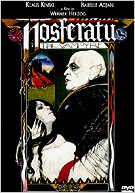 |
Site created 12/15/97.

review added: 1/31/01
Nosferatu the Vampyre
(a.k.a. Nosferatu: Phantom der Nacht)
1979 (1999) - 20th Century Fox (Anchor Bay)
review by Greg Suarez of The Digital Bits
 |
Film
Rating: B Disc Ratings (Video/Audio/Extras): D+/C-/A- Specs and Features 107 mins, PG, letterboxed widescreen (1.85:1), dual-sided (side A: German, side B: English), single-layered, Amaray keep case packaging, audio commentary with director Werner Herzog interviewed by Norman Hill, "behind-the-scenes" featurette, 2 U.S. theatrical trailers and the Spanish theatrical trailer, film-themed menu screens, scene access (29 chapters), languages: English (DD 2.0 mono) and German (DD 5.1 & 2.0 mono), subtitles: English |
Nosferatu the Vampyre is director Werner Herzog's 1979 telling of Dracula and, in many ways, is an homage to Murnau's 1922 film. The story structure of both films is very similar (but they have different endings), and Klaus Kinski (Count Dracula) is clearly made up to resemble Max Schreck. Kinski sports a bald head, pointed ears, long fingernails and two protruding incisors. He resembles Schreck in many ways, but is nowhere near as terrifying. Still, Kinski separates his portrayal by injecting a bit more sorrowful humanity into the character. His characterization is not necessarily better or worse... it's just different. Herzog's Nosferatu is also more deliberate than Murnau's, and the artfulness of the film is more external and not shrouded in mysterious symbolism. What I mean is, the 1979 version is more drawn out. It's more sprawling and is presented as a living painting. Herzog takes a different approach with much of this film, by making it ghostly rather than terrifying. Shots are composed to be surreally beautiful, not intentionally scary. That surreal beauty, blended with the dark theme of the story, is what makes this version stand out as unique. While the 1979 version of Nosferatu is a good film and an unusual aesthetic interpretation of Dracula, it lacks the effectiveness and psychological intelligence of Murnau's version. What's missing in Herzog's version is the ability of the film to creep its way into your psyche and plant seeds of fear. Instead, the film wants you to revel in its creepy atmosphere. This is not a terrifying movie... it's just really eerie. Anchor Bay's release of Nosferatu the Vampyre is disappointing. The non-anamorphic 1.85:1 image is riddled with noise, and boasts some horrendous compression artifacts. Darker scenes tend to be muddy and the black level is wanting. The video can appear detailed in places, and color rendition seems fairly accurate. But overall, this transfer is a dud. A film that relies so heavily on portrait-like images deserves a better transfer. On the audio side, Nosferatu is presented in both German and English. The German track is encoded in Dolby Digital 5.1, and sounds thin and dated. This is a real shame considering the haunting, almost hypnotic score by German group Popul Vuh. However, the 5.1 mix does allow the music to be spread around the listener for enhanced ambiance. The English version is Dolby Digital 2.0 mono, and sounds very similar to the 5.1 German mix, except for limited aural distribution. Fidelity is almost identical, but the sound is not distributed about the sound space, which curtails the ambient effect. 2.0 mono is also provided in German. Included on this disc are several supplements that give the audience a look into the making of the film. The first is an informative, if a bit dry, commentary track with director Werner Herzog, as interviewed by Norman Hill. Next is a 13-minute, "behind-the-scenes" featurette, which includes on-set interview segments with Herzog and a look at Kinski's make up application. Also in the supplemental section are two U.S. theatrical trailers and a Spanish theatrical trailer. Herzog's 1979 Nosferatu is an unusual horror film, that does a great job of creating an eerie atmosphere with its picturesque cinematography and haunting score. It's not quite as satisfying as Murnau's 1922 version, but it takes a slightly different approach and succeeds. Be warned, though - the audio and video quality of this disc leaves a lot to be desired. That said, at the very least, this disc is worthy of a rental. Greg Suarez gregsuarez@thedigitalbits.com |
Nosferatu the Vampyre

| Site
designed for 800 x 600 resolution, using 16M colors and .gif 89a
animation. © 1997-2015 The Digital Bits, Inc., All Rights Reserved. billhunt@thedigitalbits.com |